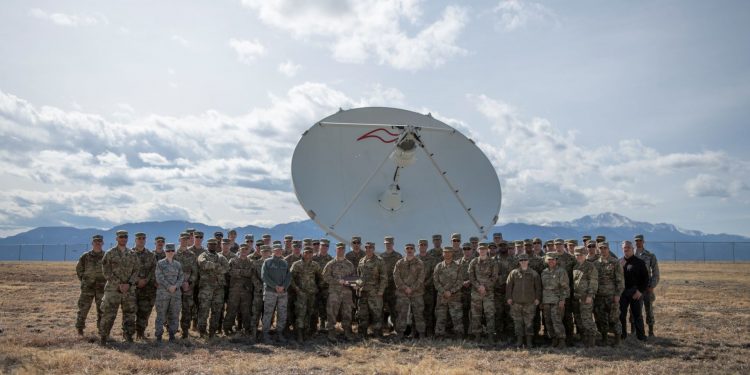The first offensive weapon system in the United States Space Force, the Counter Communications System Block 10.2, achieved Initial Operating Capability on March 9, providing quick reaction capability with direct operational support to the warfighter.
The Space and Missile Systems Center’s Special Programs directorate and the 4th Space Control Squadron held a ceremony on March 12 to commemorate this historic event handing over a key to symbolize the transfer of responsibility from the space program office to the space operations unit at Peterson Air Force Base, Colo.
The Counter Communications System, first introduced in 2004, is a transportable space electronic warfare system that reversibly denies adversary satellite communications developed in partnership with L3Harris.Col. Stephen Purdy, SMC Special Programs director, said the benefits of CCS to deployed forces and warfighters cannot be overstated.
“CCS B10.2 represents the end of the traditional way of development,” Purdy said. “Future upgrades and enhancements will make use of SMC’s Agile DevSecOps (Development, Security and Operations) approach adapting to the evolving battlefield while delivering capabilities to the warfighter faster and better than our opponents.”
Working with Total Force Airmen, the CCS team’s efforts resulted in an effective certified training program for the space control operators and satellite communications maintenance personnel.
Air National Guard units in California, Colorado and Florida and Air Force active duty units like the 4th Space Control Squadron at Peterson Air Force Base, use the CCS. Members of the Air National Guard, including some who are also civilian employees of L3Harris, worked alongside active duty counterparts at SMC and the 721st Operations Group to test and deliver a cutting-edge space electronic warfare system since January.
“The advantage of the National Guard’s unique relationship of citizen-Airmen working full-time in industry with mission partners like L3Harris, allows us to create a continuous feedback loop between system operators and contractors providing the best counter communications system,” said Lt. Col. Warren Riner, Pentagon division chief, National Guard Bureau-space operations. “We look forward to continued success operationally with the new weapon system, and working with SMC and industry partners to support the United States Space Force.”
Additionally, SMC went through a rigorous year-long test campaign that included both developmental and operational test events.
“Overall, the test campaign was extremely successful in demonstrating that CCS is operationally effective,” Maj. Seth Horner, SMC program manager, said. “We could not have been successful if not for a highly integrated and skilled team from across the CCS enterprise.”
“IOC signifies the start of CCS personnel and equipment support to USSPACECOM warfighting requirements for world-wide operations,” said Lt. Col. Steve Brogan, materiel leader of the SMC Special Programs directorate. “Achieving IOC for this upgrade puts the ‘force’ in Space Force and is critical to Space as a warfighting domain.”
With incremental software upgrades occurring since the early 2000s, SMC, along with its partner L3Harris, incorporated new techniques, frequency bands, technology refreshes and other lessons learned from its previous CCS block upgrades into CCS B10.2.










